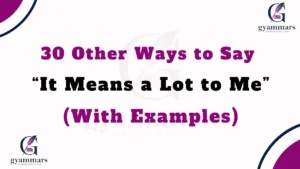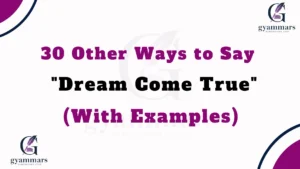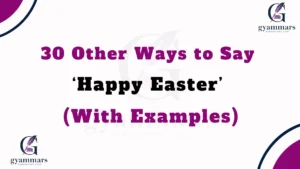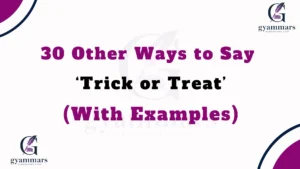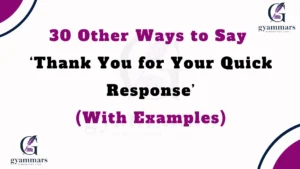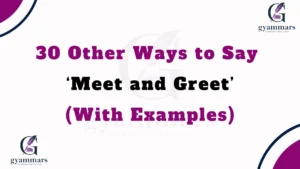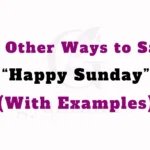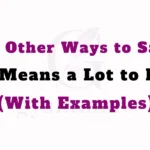Effective communication is all about the right words, tone, and context. Whether you’re sending an email, making a phone call, or chatting with someone in person, how you phrase something can make a big difference.
A simple phrase like “This is to inform you” can sometimes feel too formal or detached. However, there are plenty of alternative expressions that can make your message sound warmer, more empathetic, and more thoughtful.
Here are 30 other ways to say “This is to inform you,” with examples and scenarios for when to use each one. By the end, you’ll be equipped to express yourself in ways that feel more personal and sincere.
What Does “This Is to Inform You” Mean?
“This is to inform you” is a formal, somewhat stiff phrase often used in professional or official communication. It is typically a prelude to delivering information to the recipient, signaling that important details or news are coming.
In most cases, this phrase is neutral in tone and doesn’t convey much warmth. While it gets the job done, there are many other ways to deliver the same message with more compassion, empathy, and care.
Is It Professional/Polite to Say “This Is to Inform You”?
While “This is to inform you” can be professional and polite in many formal contexts, it can sometimes sound distant or impersonal. Depending on your audience, you might want to consider alternatives that soften the tone or add more warmth.
When writing formal letters or emails, especially in business settings, using “This is to inform you” is perfectly acceptable. However, when addressing clients, colleagues, or friends, it’s often beneficial to explore other options to make your communication feel more engaging and thoughtful.
Pros and Cons of “This Is to Inform You”
Pros:
- Professional and formal.
- Clear and to the point.
- Suitable for official communication.
Cons:
- Can sound cold or impersonal.
- Lacks warmth and empathy.
- Overused in formal settings, making it feel stiff.
Synonyms For This Is to Inform You
- I Wanted to Let You Know
- Just a Quick Update
- I Thought You Should Know
- I’d Like to Share
- Just So You Know
- I Want to Make You Aware
- Allow Me to Inform You
- I’d Like to Bring to Your Attention
- For Your Information
- Just a Heads Up
- Wanted to Keep You in the Loop
- Just Wanted to Let You Know
- I’d Like to Keep You Informed
- Just Thought I’d Mention
- I Would Like to Notify You
- I Need to Let You Know
- You Should Be Aware That…
- Please Be Advised
- I’d Like to Keep You Updated
- I Want to Bring This to Your Attention
- I’d Like to Notify You
- Just Wanted to Pass Along This Information
- I Have Some Important News to Share
- This Is a Heads-Up
- Letting You Know in Advance
- I Wanted to Bring This Up
- I’m Writing to Inform You
- I Wanted to Keep You in the Loop
- You Might Find This Useful
- I Want to Update You On…
1. “I Wanted to Let You Know”
Definition: A friendly way of introducing information.
Detailed Explanation: This phrase softens the tone, making it feel like you’re taking the time to communicate personally, rather than just delivering information.
Scenario Example:
- “I wanted to let you know that the meeting has been rescheduled for next Thursday.”
Best Use: Emails to colleagues, friends, or casual work-related updates.
Tone: Friendly, warm, personal.
Additional Notes: Great for informal communication but still professional.
2. “Just a Quick Update”
Definition: A concise way to offer new information.
Detailed Explanation: This phrase suggests you’re providing brief but important information without overwhelming the recipient.
Scenario Example:
- “Just a quick update on the project: everything is on track for the deadline.”
Best Use: Casual or quick work-related emails, team messages.
Tone: Casual, easygoing.
Additional Notes: Ideal for quick communication that doesn’t require a formal tone.
3. “I Thought You Should Know”
Definition: Implies the information is important or relevant for the recipient to be aware of.
Detailed Explanation: This phrase is slightly more personal, indicating that you’ve considered the recipient’s need to know the information.
Scenario Example:
- “I thought you should know that we’ve decided to extend the application deadline.”
Best Use: Informing someone of something significant or that affects them directly.
Tone: Thoughtful, considerate.
Additional Notes: It conveys care and attention to detail.
4. “I’d Like to Share”
Definition: A soft and inviting way to present new information.
Detailed Explanation: By using “I’d like to share,” the information feels more collaborative and less like an official statement.
Scenario Example:
- “I’d like to share some exciting news about the upcoming product launch.”
Best Use: Newsletters, client communication, or friendly updates.
Tone: Warm, inviting, personal.
Additional Notes: Great for building connection and positivity.
5. “Just So You Know”
Definition: A friendly way of letting someone know something without sounding too formal.
Detailed Explanation: This phrase is often used to convey information in a laid-back, non-urgent manner.
Scenario Example:
- “Just so you know, we’re working on the issue you raised in the meeting.”
Best Use: Informal updates, quick email responses, or when you don’t need to sound too serious.
Tone: Casual, relaxed.
Additional Notes: Great for brief, non-urgent messages.
6. “I Want to Make You Aware”
Definition: Slightly more formal but still inviting.
Detailed Explanation: This is a clear way of indicating that the recipient should pay attention to what follows.
Scenario Example:
- “I want to make you aware that the system will be down for maintenance over the weekend.”
Best Use: Professional or official contexts where the recipient needs to be fully aware.
Tone: Clear, direct.
Additional Notes: More formal but still polite and considerate.
7. “Allow Me to Inform You”
Definition: A formal and respectful way of presenting information.
Detailed Explanation: This phrase sounds more sophisticated and is commonly used in formal letters or professional settings.
Scenario Example:
- “Allow me to inform you that the terms of the agreement have been updated.”
Best Use: Business correspondence, formal notices.
Tone: Formal, respectful.
Additional Notes: Best suited for formal communication or official letters.
8. “I’d Like to Bring to Your Attention”
Definition: A formal and respectful expression used when informing someone about something important.
Detailed Explanation: This phrase is often used in business or legal contexts to make the recipient aware of important matters.
Scenario Example:
- “I’d like to bring to your attention that the proposal has been revised.”
Best Use: Formal communication, especially in business or legal settings.
Tone: Formal, respectful.
Additional Notes: It’s a bit more formal and detailed.
9. “For Your Information”
Definition: A neutral way to provide information without implying urgency.
Detailed Explanation: This phrase can come across as slightly detached, so it’s important to use it with care, especially in personal contexts.
Scenario Example:
- “For your information, we will be closing early on Friday.”
Best Use: Neutral, formal communication, or when the message doesn’t need a personal touch.
Tone: Neutral, straightforward.
Additional Notes: Use when you don’t need to add extra warmth.
10. “Just a Heads Up”
Definition: An informal way of providing a warning or piece of information in advance.
Detailed Explanation: This phrase is often used in casual communication and suggests the information is important but not urgent.
Scenario Example:
- “Just a heads up, we’re expecting delays with the delivery.”
Best Use: Casual email, quick team message.
Tone: Informal, light.
Additional Notes: Good for non-urgent updates.
11. “Wanted to Keep You in the Loop”
Definition: A friendly, informal way to let someone know they are being kept updated on a situation.
Detailed Explanation: This phrase is useful when you want to let someone know they’re part of the ongoing conversation or process.
Scenario Example:
- “I wanted to keep you in the loop regarding the client meeting.”
Best Use: Casual, friendly updates.
Tone: Friendly, inclusive.
Additional Notes: Excellent for team communication.
12. “Just Wanted to Let You Know”
Definition: A slightly softer alternative that is still informal but friendly.
Detailed Explanation: This version of the phrase feels less stiff and more conversational.
Scenario Example:
- “Just wanted to let you know that we received your feedback.”
Best Use: Casual emails or informal updates.
Tone: Casual, warm.
Additional Notes: Perfect for everyday updates.
13. “I’d Like to Keep You Informed”
Definition: A polite way to let someone know that you are providing them with information to stay up to date.
Detailed Explanation: This phrase emphasizes the importance of the recipient staying informed.
Scenario Example:
- “I’d like to keep you informed about the progress of the project.”
Best Use: Professional emails or newsletters.
Tone: Polite, considerate.
Additional Notes: Great for ongoing communication.
14. “Just Thought I’d Mention”
Definition: A casual, informal way of introducing information.
Detailed Explanation: This phrase makes it sound like the information is not critical but still useful to know.
Scenario Example:
- “Just thought I’d mention that the office will be closed on Monday.”
Best Use: Informal communication, light updates.
Tone: Casual, conversational.
Additional Notes: Ideal for less formal settings.
15. “I Would Like to Notify You”
Definition: A formal way to provide important information.
Detailed Explanation: This phrase is more formal and often used in official communications.
Scenario Example:
- “I would like to notify you that the meeting time has changed.”
Best Use: Formal emails, legal notices.
Tone: Formal, authoritative.
Additional Notes: Appropriate for official settings where you need to convey authority.
16. “I Need to Let You Know”
Definition: A direct way to inform someone that they should be aware of something.
Detailed Explanation: This phrase emphasizes the importance of the information being shared, making it sound urgent or necessary.
Scenario Example:
- “I need to let you know that we are changing our service hours starting next month.”
Best Use: When you want to stress the necessity of the information.
Tone: Serious, direct, clear.
Additional Notes: Best used when urgency is involved, but still keeps the message conversational.
17. “You Should Be Aware That…”
Definition: A phrase that indicates that the recipient needs to know something important.
Detailed Explanation: It is slightly formal but still engaging, making it useful for professional and official communication.
Scenario Example:
- “You should be aware that the contract renewal deadline is approaching.”
Best Use: Business communications, legal updates, or policies.
Tone: Professional, informative.
Additional Notes: More serious than casual alternatives but still polite.
18. “Please Be Advised”
Definition: A formal way of giving notice about something important.
Detailed Explanation: This phrase is often used in legal, business, or official communications to convey authority.
Scenario Example:
- “Please be advised that the company will be closed for the holidays from December 24 to January 2.”
Best Use: Official notices, legal documents, company policies.
Tone: Formal, authoritative.
Additional Notes: Can sometimes sound too official, so it’s best used in strictly professional settings.
Read More: 30 Other Ways to Say “Mind Your Own Business” (With Examples)
19. “I’d Like to Keep You Updated”
Definition: A polite and professional way to ensure someone stays informed.
Detailed Explanation: This phrase implies an ongoing effort to share information, making it ideal for project updates or continuous communication.
Scenario Example:
- “I’d like to keep you updated on the latest changes to our product line.”
Best Use: Project updates, work-related emails, newsletters.
Tone: Professional, friendly, engaging.
Additional Notes: Encourages ongoing communication.
20. “I Want to Bring This to Your Attention”
Definition: A respectful way to highlight something important.
Detailed Explanation: This phrase indicates that the information is significant and needs the recipient’s attention.
Scenario Example:
- “I want to bring this to your attention before the final decision is made.”
Best Use: Meetings, business discussions, or serious conversations.
Tone: Formal, serious, respectful.
Additional Notes: Great for when you need someone to focus on an issue.
21. “I’d Like to Notify You”
Definition: A professional and respectful way of informing someone.
Detailed Explanation: This phrase is often used in official settings when a formal notification is required.
Scenario Example:
- “I’d like to notify you that your application has been approved.”
Best Use: Business emails, legal notices, HR updates.
Tone: Formal, professional.
Additional Notes: Best for official or structured communication.
22. “Just Wanted to Pass Along This Information”
Definition: A casual way of sharing information without making it seem too serious.
Detailed Explanation: This phrase makes the information feel more natural and conversational, as if you’re passing it along informally.
Scenario Example:
- “Just wanted to pass along this information in case it’s useful to you.”
Best Use: Internal work emails, team chats, friendly updates.
Tone: Casual, relaxed, friendly.
Additional Notes: Keeps things light but informative.
23. “I Have Some Important News to Share”
Definition: A phrase that signals that the information being shared is significant.
Detailed Explanation: It adds a sense of weight to the news, making the recipient more likely to pay attention.
Scenario Example:
- “I have some important news to share regarding our company’s expansion.”
Best Use: Announcements, leadership messages, company updates.
Tone: Serious, professional, engaging.
Additional Notes: Good for big updates.
24. “This Is a Heads-Up”
Definition: A casual way to inform someone in advance.
Detailed Explanation: Often used to let someone know about upcoming events or potential issues.
Scenario Example:
- “This is a heads-up that we might have delays in the project.”
Best Use: Friendly reminders, informal emails.
Tone: Casual, friendly.
Additional Notes: Good for non-urgent messages.
25. “Letting You Know in Advance”
Definition: A way to inform someone before something happens.
Detailed Explanation: This phrase is useful when you want to prepare someone for upcoming changes or events.
Scenario Example:
- “Letting you know in advance that the website will undergo maintenance this weekend.”
Best Use: Scheduling emails, event planning.
Tone: Considerate, thoughtful.
Additional Notes: Helps avoid surprises.
26. “I Wanted to Bring This Up”
Definition: A way to introduce a topic for discussion.
Detailed Explanation: This phrase suggests the information is important and worth talking about.
Scenario Example:
- “I wanted to bring this up before the team meeting tomorrow.”
Best Use: Discussions, collaborative work.
Tone: Neutral, polite.
Additional Notes: Works well for group settings.
27. “I’m Writing to Inform You”
Definition: A formal way to introduce information in written communication.
Detailed Explanation: This phrase is commonly used in professional emails and official letters.
Scenario Example:
- “I’m writing to inform you that your request has been processed.”
Best Use: Emails, business letters.
Tone: Formal, professional.
Additional Notes: Perfect for official messages.
28. “I Wanted to Keep You in the Loop”
Definition: A casual way of ensuring someone stays updated.
Detailed Explanation: This phrase is great for making the recipient feel included.
Scenario Example:
- “I wanted to keep you in the loop about the latest developments.”
Best Use: Team updates, ongoing projects.
Tone: Friendly, engaging.
Additional Notes: Encourages teamwork.
29. “You Might Find This Useful”
Definition: A subtle way of providing information without making it seem obligatory.
Detailed Explanation: This phrase makes it sound like the information is beneficial rather than mandatory.
Scenario Example:
- “You might find this useful when preparing your presentation.”
Best Use: Advice, recommendations.
Tone: Helpful, considerate.
Additional Notes: Works well for suggestions.
30. “I Want to Update You On…”
Definition: A direct way to introduce an update.
Detailed Explanation: This phrase makes it clear that you are providing new information.
Scenario Example:
- “I want to update you on the latest changes to our policies.”
Best Use: Professional and work-related updates.
Tone: Professional, neutral.
Additional Notes: Keeps communication direct and clear.
Frequently Asked Questions (FAQs)
1. Is it okay to use these alternatives in formal emails?
Yes, many of these alternatives can be used in formal emails, especially those like “I’d like to notify you,” “I want to bring this to your attention,” and “Please be advised.” These phrases are polite, professional, and still respectful.
2. Can I use these alternatives in casual conversations?
Absolutely! Phrases like “Just a heads up,” “Just wanted to let you know,” and “I thought you should know” are perfect for casual conversations or informal emails. They help maintain a friendly tone while sharing important information.
3. What tone is best for using these alternatives?
The tone you choose depends on the situation. Formal alternatives work well in professional or official settings, while casual phrases are better for team conversations or personal updates. It’s important to match the tone to the audience and context.
4. Should I always avoid using “This is to inform you”?
Not necessarily. “This is to inform you” is still a valid and professional way to deliver information. However, if you want to sound more approachable, warm, or engaging, consider using one of the alternatives provided. It’s all about finding the right fit for the message.
5. Can these phrases help me sound more professional?
Yes, using thoughtful and polite alternatives can help you sound more professional and empathetic. They show that you care about how your message is received and that you’re actively trying to engage with your audience.
Conclusion
In the world of communication, how you express yourself matters just as much as the message itself. Finding the right words can transform your interactions and make the information you share feel more thoughtful, approachable, and meaningful. Whether you’re writing a business email, sending a quick update to a colleague, or simply informing someone of important news, these 30 alternatives to “This is to inform you” offer you a variety of ways to convey your message in a warm and engaging manner.
By using these alternatives, you’re not only delivering information—you’re also creating stronger connections with your audience. So, don’t be afraid to mix things up and explore new ways to communicate that feel more personal and genuine. Your message will be better received, and you’ll be able to foster a more positive, engaging environment.

“Emma Rose at Grammar Synonyms is your go-to expert for everything related to language and expression. Whether you’re refining your grammar, searching for the perfect synonym, or looking for creative ways to improve your writing, Emma Rose provides the tools and inspiration you need. With a wide range of resources designed to elevate your communication, Grammar Synonyms helps you find just the right words to make every sentence shine.


